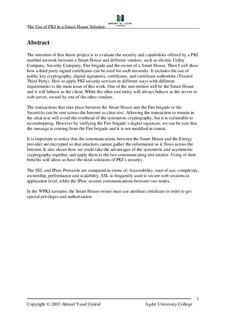| dc.description.abstract | The intention of this thesis project is to evaluate the security and capabilities offered by a PKI enabled network between a Smart House and different vendors, such as electric Utility Company, Security Company, Fire brigade and the owner of a Smart House. Then I will show how a third party signed certificates can be used for such networks. It includes the use of public key cryptography, digital signatures, certificates, and certificate authorities (Trusted Third Party). How to apply PKI security services in different ways with different requirements is the main issue of this work. One of the end entities will be the Smart House and it will behave as the client. While the other end entity will always behave as the server or web server, owned by one of the other vendors.
The transactions that take place between the Smart House and the Fire brigade or the SecuritAs can be sent across the Internet as clear text. Allowing the transaction to remain in the clear text will avoid the overhead of the symmetric cryptography, but it is vulnerable to eavesdropping. However by verifying the Fire brigade’s digital signature, we can be sure that the message is coming from the Fire brigade and it is not modified in transit.
It is important to notice that the communications between the Smart House and the Energy provider are encrypted so that attackers cannot gather the information as it flows across the Internet. It also shows how we could take the advantages of the symmetric and asymmetric cryptography together, and apply them to the two communicating end entities. Using of their benefits will allow us have the ideal solutions of PKI’s security.
The SSL and IPsec Protocols are compared in terms of; Accessibility, ease of use, complexity, ownership, performance and scalability. SSL is frequently used to secure web sessions at application level, while the IPsec secures communications between two nodes.
In the WPKI scenario, the Smart House owner must use attribute certificate in order to get special privileges and authorization. | en |
